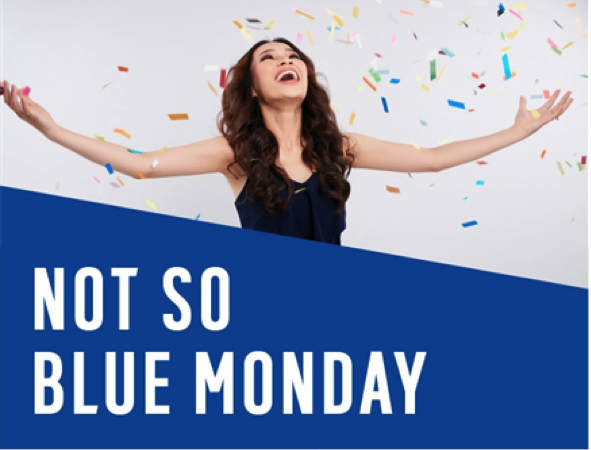Email Engagement
Blue Skies, Not Blue Monday – 5 Great Email Tactics to Survive 2020’s Most Miserable Day!
minute read

January 20th is “Blue Monday” (yes – it’s really a thing!). It’s officially the most depressing day of the year, because of a combination of post-Christmas bills, broken relationships, abandonment of New Year resolutions, payday poverty, low sunlight levels and cold weather. Learn more about Blue Monday here.
Marketers are recognising this as a new opportunity to engage with their customers, and I’ve collated some great examples of how they approached Blue Monday last year.
1. Sell Some Sunshine!
In the dank depths of northern hemisphere winter the promise of something brighter and warmer is a guaranteed winner. Virgin Atlantic sold the dream of being in a better place, reinforced with the following seductive copy:
Do you have to be down in the dumps this month? People often believe myths like the January Blues because they’ve never taken the time to question them. What if January could be the best month of the year? How about waking up in the morning and grabbing the day with both hands, saying screw it, let’s do it!
Our Kind of Blue Monday
In her excellent book Sensation, leading psychologist Thalma Lobel explains the principles of embodied cognition – how external stimuli like colour and temperature exert influence on the way people’s minds work. Good email can harness this, and Virgin Atlantic’s customers will almost be feeling the sense of sun on their skin, and sand on the soles of their feet, and will be inspired to forward to family/friends/colleagues – and make bookings!
2. Create Some Comfort
Nespresso took a similar approach, inviting subscribers to ease the Blue Monday pain by spoiling themselves with a rich, aromatic cup of coffee:
It may be Blue Monday, but there’s still good reasons to be cheerful. Treat yourself to your favorite Nespresso coffee, and let the January blues fade away.
Reasons to Stay Cheerful
This example also leverages embodied cognition – subscribers will be responsive to the suggestion of the smell of freshly brewed coffee, and react positively because of this. The email then built on this by also encouraging subscribers to indulge themselves with some delicious honey crunch biscuits and pistachio cakes – they would have been drooling by this point! The email ended with a summary of recipients’ membership status (Connoisseur, Expert, Ambassador) making them feel a little more special even on this darkest of days!
3. Sweat that Pre-Header
While great subject lines play a key role in getting emails opened, great pre-headers are just as important. While subject lines typically truncate after 35-40 characters on most mobile devices, approximately twice as much pre-header text gets displayed (70-80 characters). Smart email marketers harness this opportunity, coupling the two elements together to create stronger calls to action, and we saw two great examples from New Look and House of Fraser:
4. Celebrate Being Special!
When customers are wallowing in the depths of their Blue Monday funk, what better time to make them feel a little more special – especially if they can also save money at the same time! Virgin Mobile took the initiative with this great value statement email.
“[Name], you’re one of us. So you get the best from us”
The subject line didn’t specifically reference Blue Monday, but the copy most certainly did!
January payday still not here? No worries, we’re here to help you save those pennies and squeeze every last bit of awesomeness out of your mobile!
Virgin reminded customers of their unlimited Wi-Fi access, free access to 0800 numbers, and tips to save against their data allowances. And – perhaps most importantly – they took the opportunity to say “Thank You!”.
Brighten Blue only – scoop Nectar points with eBay
Nectar and eBay also got in on the act, rewarding purchases with bonus points, which were only available for the 24-hour period that Blue Monday lasted!
5. We’re All in it Together
Argos presented their email as a survival guide, with tips to get through Blue Monday:
Say no to Blue Monday
Subscribers were encouraged to cheer themselves up by spending family time with their great range of board games, starting preparations for their summer holidays, treating themselves to an experience day, and upgrading their wardrobes!
Argos subscribers loved this email, and it was one of the sender’s best performing promotions last January!
While these emails are light-hearted in intent, they also served a serious purpose. Adobe’s Consumer Email Survey asked email subscribers what one thing they would change about the messages they receive, and the top response was “Make them less about promotion!”. Epsilon’s Email Trends & Benchmarks report provides the numbers to back this up. Non-promotional emails (excluding service and triggered emails) generate open rates that are ± 1.2X higher than their promotional counterparts and click rates that are 2X higher.
Successful email marketers know that subscriber engagement is a function of value exchange. The DMA’s Data Privacy – What the Consumer Really Thinks report shows a full 50% of consumers are “pragmatists” who will provide personal data on a case by case basis depending whether the service offered is worth the information requested. While perceived value takes obvious forms (offers and discounts) it is also perceived in the form of useful information, value statements, time savings . . . and even simply showing appreciation!
Especially in the context of Blue Monday, these points are highly relevant. Glum consumers clearly thrive on being shown a little love on the most miserable day of the year and will respond in kind. What can we expect to see this year?
- Consumers are definitely feeling the financial strain so emails helping them save money, or stretching what little is left, will be well received!
- People are feeling down, so messages making them feel special and cared for will be appreciated.
- It’s a time of sensory deprivation (low vitamin D levels) so warm colours and bright imagery will have a positive impact.
- We can all use a good joke, so expect plenty of humour, that may even get a little risqué (the House of Fraser email finished with “a little self-gifting couldn’t hurt!”).
- Because Blue Monday is still a fairly new concept, watch out for clues in the subject lines and pre-headers explaining what’s happening – and boosting open rates!
Want more Blue Monday inspiration. Read this great article in Marketing Week, then check your inboxes to see which senders are showing you some red hot love this Blue Monday!






